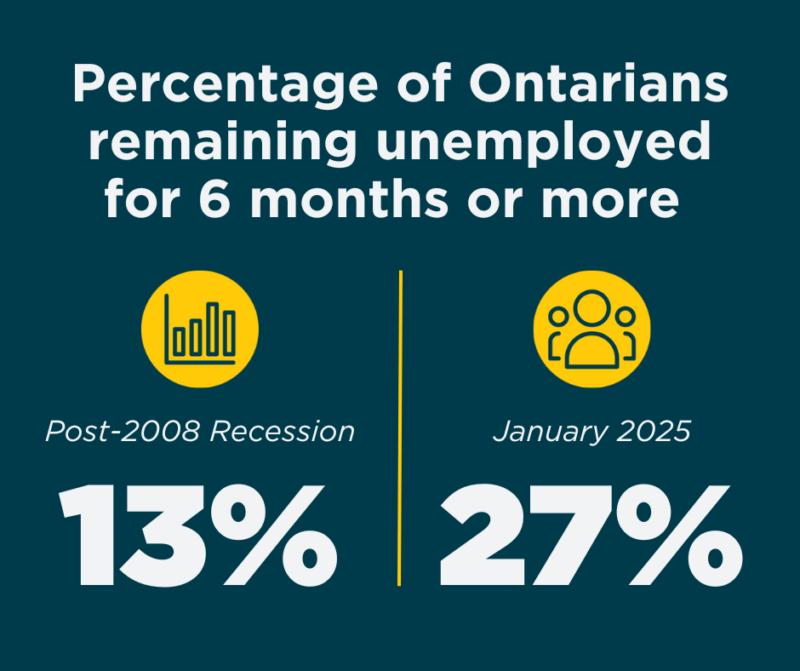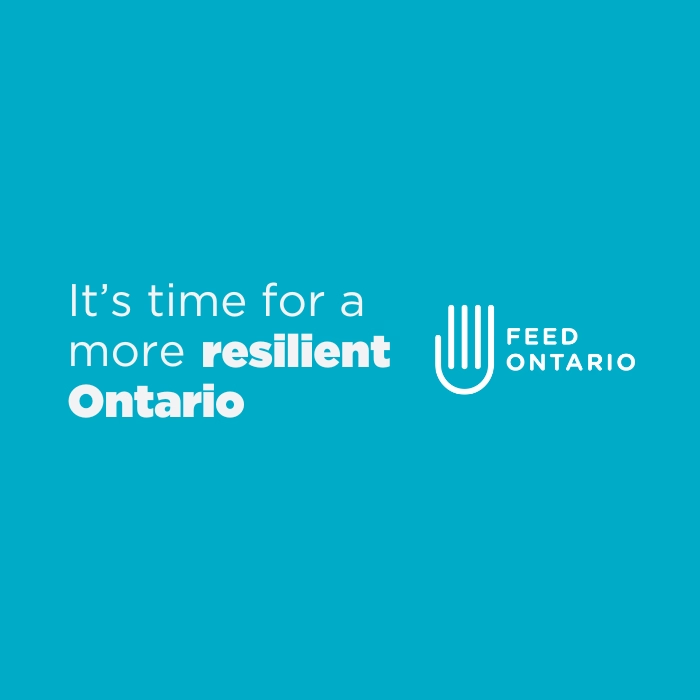If you lost your job tomorrow, how long would it take until you needed to use a food bank? This is becoming a more pressing question for many Ontarians due to our current economic uncertainty and is something for the new government to consider when working to build a more resilient Ontario by strengthening our social safety net.
Over the past two decades, we’ve endured a recession, a pandemic, unprecedented inflation, and the emerging threat of large-scale job losses. The future holds even more uncertainty: changing governments, a growing number of natural disasters due to climate change, and further strides in automation. On top of all of these unknowns, food banks are facing unsustainable levels of growth in need for their services. This make the instability many in Ontario are experiencing as a result of these challenges even more precarious.
The need for a stronger social safety net
Most people are unable to weather these types of storms on their own. Between the rise in precarious work, the housing crisis, and recent spikes in inflation, having enough left over to save for a rainy day has become harder than ever. An astounding 47% of our neighbours report living paycheque to paycheque, and only 1 in 4 are able to cover an unexpected expense of $500 or more.
This is why our governments and communities built a social safety net over the course of many decades. For many Canadians, it is a point of pride as well as a source of comfort, helping to ensure that there would be a safe landing in the event of an emergency. It is also a matter of good public policy to stabilize our economy and prevent short-term setbacks from becoming long-term disasters.
Unfortunately, after years of disinvestments, this social safety net is weaker than ever. As a result, many Ontarians are far closer to needing to use a food bank than they may even realize.
Employment Insurance doesn’t protect many Ontarians
If you did lose your job tomorrow, your first step would likely be to apply for Employment Insurance (EI). However, while EI has been a mainstay of our social safety net since 1940, many are surprised to learn that most Ontarians aren’t able to quality for the program today. In November, less than a quarter of the 680,600 unemployed people in Ontario received EI, the lowest rate out of all the provinces. Even if you are eligible, the support is finite. On top of this, we’re currently seeing trends of unemployment in Ontario lasting longer, with long-term unemployment rates higher than they were after the 2008 global recession.
EI wasn’t always this difficult to access. In the 1970s, to qualify for EI, a worker only needed to have worked 170 hours in the last year. Today, you need to have worked between 560 to 700 hours. This issue is compounded by the growth in precarious work, with more people working shorter and more unpredictable hours and therefore unable to qualify. EI does not cover the solo self-employed or gig workers, jobs which tend to be lower-paid and less stable to begin with, and that now make up 6% of Ontario’s workforce.
Ontario Works can make it harder to stay on your feet
If you are among the 3 in 4 unemployed Ontarians that don’t qualify for EI, you might turn to provincial social assistance, made up of Ontario Works (OW) and the Ontario Disability Support Program (ODSP). OW is designed to “help people in financial need find sustainable employment and achieve self-reliance.” Yet in many ways, the program can make it harder to stay on your feet, resulting in a temporary rough patch becoming a hole that is near-impossible to dig out of.
To qualify, you must first spend down most of your savings, including what you might have put away for retirement, increasing your long-term financial vulnerability. Once you’re on OW, the maximum amount you can receive is $733 a month, making it impossible to afford today’s cost of living. While the goal of the program is to support people while they work to find a good job, it’s incredibly difficult to do so under the stress of trying to live on $733 per month. When this amount doesn’t even cover the cost of your rent, much less your phone bill for calls from prospective employers, your transportation to get to an interview, or your breakfast so you can focus on the questions the hiring manager is asking you, struggling to get by can become a barrier to finding work.
Maybe you’re able to get a part-time job right away. With how difficult the job market is right now, perhaps landing work could feel like hitting the lottery. But then, while you’re working hard to make a good impression at your new position and pursuing chances to get more hours, you find out that for every dollar you earn, your OW cheque gets clawed back by 50 cents.
Perhaps you’re not so lucky, and you join the 27% of unemployed Ontarians who’ve been out of work for more than half a year. If that $733 a month doesn’t cover your rent now, it’s unlikely you’ll be able to find a new place you can afford when the average asking price for a bachelor apartment in Ontario is $1,777. In that case, you may end up among the more than 22,000 OW recipients who are experiencing homeless (a rate double just two years ago), and your monthly cheque drops down to $343 because you are no longer eligible to receive the “shelter” portion of the benefit.

The percentage of Ontarians remaining unemployed for 6 months or more, 2009 vs. 2025. Data from Statistics Canada.
Food banks are seeing unsustainable growth in need for their services
It’s understandable that many people who have had to turn to OW eventually need to access a food bank to get by. The realities of OW mean that you will most likely need the support of your community to make ends meet, perhaps sooner than you ever thought possible. Unfortunately, your food bank is already facing a rapid increase in demand for emergency food assistance, as you have joined the over one million Ontarians from all walks of life who will visit a food bank this year.
Food banks are up against the same economic pressures everyone in the province is experiencing, and fewer people in the community have been able to support their work through donations. At the same time, the amount of visitors food banks are serving has doubled since 2018, and some food banks have reported that those who once donated are now turning to them for help. Food banks typically receive little to no government funding, and are being forced to do more with less resources available, stretching them beyond their limits.
A better future and a stronger social safety net are possible
Although this fate sounds bleak, it is not inevitable. We used to have a robust system of income support programs and affordable housing, and we can have one again. A better future is possible, but it requires us to build popular support for a stronger social safety net and call on the government to create policies that will build it back up.
While we are glad to see provincial parties calling on the federal government to urgently reform EI, there are many improvements that the new provincial government can make to Ontario Works to ensure that those who fall on hard times stay on their feet. Increasing financial support provided by OW and ODSP would give people a higher and more stable floor from which to rebuild. Reducing clawbacks on earnings and other benefits would allow people to keep more of their money while they regain financial independence. Ensuring that everyone receives a consistent level of support, regardless of living situation, would help to prevent homelessness. Excluding resources like RRSPs from the eligibility test for OW would mean that people no longer have to drain their retirement savings to access temporary help during their working years.
Much about Ontario’s economic future remains uncertain. There is no crystal ball to tell us what the outcomes of the threats we face now will be, and there is so much that we cannot control. However, it is firmly within our power to shore up our social safety net so we are better able to weather the storms of tomorrow. It’s time to take this opportunity to prioritize people and a build more resilient Ontario.
If you’re interested in staying up-to-date with Feed Ontario’s work or learning more, sign up for our newsletter here: https://ow.ly/FQUq50V3KWV
